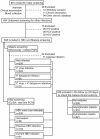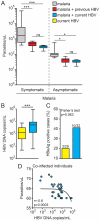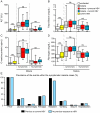Hepatitis B infection is associated with asymptomatic malaria in the Brazilian Amazon
- PMID: 21625634
- PMCID: PMC3097216
- DOI: 10.1371/journal.pone.0019841
Hepatitis B infection is associated with asymptomatic malaria in the Brazilian Amazon
Abstract
Background: Areas that are endemic for malaria are also highly endemic for hepatitis B virus (HBV) infection. Nevertheless, it is unknown whether HBV infection modifies the clinical presentation of malaria. This study aimed to address this question.
Methodology and findings: An observational study of 636 individuals was performed in Rondônia, western Amazon, Brazil between 2006 and 2007. Active and passive case detections identified Plasmodium infection by field microscopy and nested Polymerase Chain Reaction (PCR). HBV infections were identified by serology and confirmed by real-time PCR. Epidemiological information and plasma cytokine profiles were studied. The data were analyzed using adjusted multinomial logistic regression. Plasmodium-infected individuals with active HBV infection were more likely to be asymptomatic (OR: 120.13, P<0.0001), present with lower levels of parasitemia and demonstrate a decreased inflammatory cytokine profile. Nevertheless, co-infected individuals presented higher HBV viremia. Plasmodium parasitemia inversely correlated with plasma HBV DNA levels (r = -0.6; P = 0.0003).
Conclusion: HBV infection diminishes the intensity of malaria infection in individuals from this endemic area. This effect seems related to cytokine balance and control of inflammatory responses. These findings add important insights to the understanding of the factors affecting the clinical outcomes of malaria in endemic regions.
Conflict of interest statement
Figures





Similar articles
-
Hepatitis B virus infection does not significantly influence Plasmodium parasite density in asymptomatic infections in Ghanaian transfusion recipients.PLoS One. 2012;7(11):e49967. doi: 10.1371/journal.pone.0049967. Epub 2012 Nov 21. PLoS One. 2012. PMID: 23185500 Free PMC article.
-
[Seroprevalence of hepatitis B and malaria infection in Lábrea, Brazilian western Amazon: estimates of coinfection rates].Rev Soc Bras Med Trop. 2005 May-Jun;38(3):218-23. doi: 10.1590/s0037-86822005000300002. Epub 2005 May 4. Rev Soc Bras Med Trop. 2005. PMID: 15895171 Portuguese.
-
Asymptomatic malaria and hepatitis B do not influence cytokine responses of persons involved in chronic sedentary activities.BMC Infect Dis. 2020 Dec 14;20(1):957. doi: 10.1186/s12879-020-05692-2. BMC Infect Dis. 2020. PMID: 33317454 Free PMC article.
-
Chronic hepatitis B virus infection drives changes in systemic immune activation profile in patients coinfected with Plasmodium vivax malaria.PLoS Negl Trop Dis. 2019 Jun 24;13(6):e0007535. doi: 10.1371/journal.pntd.0007535. eCollection 2019 Jun. PLoS Negl Trop Dis. 2019. PMID: 31233500 Free PMC article.
-
Towards a precise test for malaria diagnosis in the Brazilian Amazon: comparison among field microscopy, a rapid diagnostic test, nested PCR, and a computational expert system based on artificial neural networks.Malar J. 2010 May 6;9:117. doi: 10.1186/1475-2875-9-117. Malar J. 2010. PMID: 20459613 Free PMC article.
Cited by
-
Hepatitis B virus infection does not significantly influence Plasmodium parasite density in asymptomatic infections in Ghanaian transfusion recipients.PLoS One. 2012;7(11):e49967. doi: 10.1371/journal.pone.0049967. Epub 2012 Nov 21. PLoS One. 2012. PMID: 23185500 Free PMC article.
-
Seroprevalence of Malaria and Hepatitis B Coinfection among Pregnant Women in Tamale Metropolis of Ghana: A Cross-Sectional Study.Can J Infect Dis Med Microbiol. 2018 Sep 24;2018:5610981. doi: 10.1155/2018/5610981. eCollection 2018. Can J Infect Dis Med Microbiol. 2018. PMID: 30344800 Free PMC article.
-
Distinct inflammatory profile underlies pathological increases in creatinine levels associated with Plasmodium vivax malaria clinical severity.PLoS Negl Trop Dis. 2018 Mar 29;12(3):e0006306. doi: 10.1371/journal.pntd.0006306. eCollection 2018 Mar. PLoS Negl Trop Dis. 2018. PMID: 29596409 Free PMC article.
-
Chronic bystander infections and immunity to unrelated antigens.Cell Host Microbe. 2012 Oct 18;12(4):458-69. doi: 10.1016/j.chom.2012.10.001. Cell Host Microbe. 2012. PMID: 23084915 Free PMC article. Review.
-
Prevalence of and risk factors for Plasmodium spp. co-infection with hepatitis B virus: a systematic review and meta-analysis.Malar J. 2020 Oct 15;19(1):368. doi: 10.1186/s12936-020-03428-w. Malar J. 2020. PMID: 33059662 Free PMC article.
References
-
- Schofield L, Grau GE. Immunological processes in malaria pathogenesis. Nat Rev Immunol. 2005;5:722–735. - PubMed
-
- Brown AE, Mongkolsirichaikul D, Innis B, Snitbhan R, Webster HK. Falciparum malaria modulates viremia in chronic hepatitis B virus infection. J Infect Dis. 1992;166:1465–1466. - PubMed
-
- Barcus MJ, Hien TT, White NJ, Laras K, Farrar J, et al. Short report: hepatitis b infection and severe Plasmodium falciparum malaria in Vietnamese adults. Am J Trop Med Hyg. 2002;66:140–142. - PubMed
Publication types
MeSH terms
Substances
LinkOut - more resources
Full Text Sources
Medical

